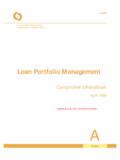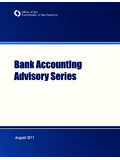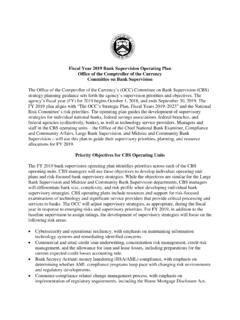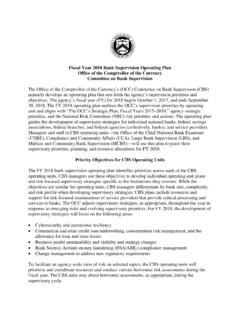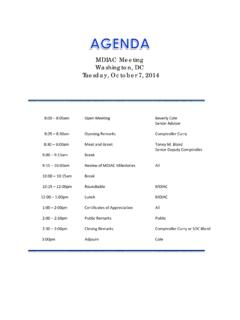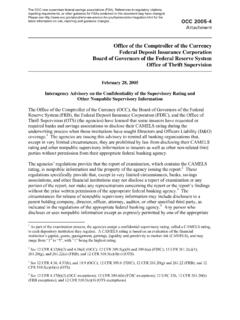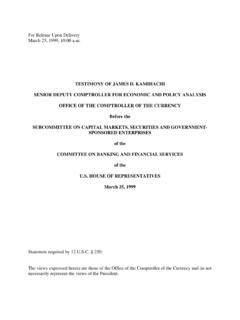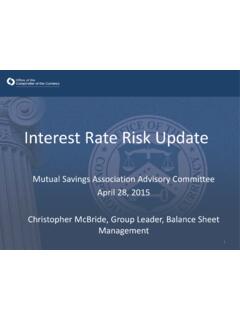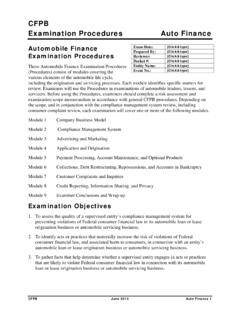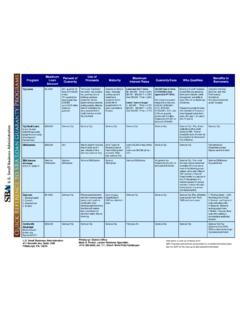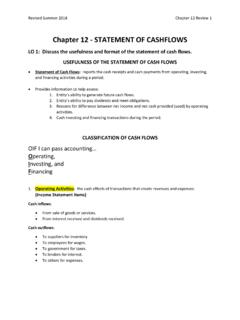Transcription of Commercial Real Estate Lending - Office of the Comptroller ...
1 Safety and Soundness Office of theComptroller of the CurrencyWashington, DC 20219 Comptroller s Handbook Management (M)Earnings (E)Liquidity(L)Sensitivity toMarket Risk(S)OtherActivities(O)AssetQuality(A) CapitalAdequacy(C)A-CREC ommercialReal Estate LendingVersion , August 2013 Version , January 27, 2017 Version Contents Introduction ..1 Overview .. 1 Background .. 1 Authority and Limits .. 1 real Estate Markets .. 2 Risks Associated With CRE Lending .. 3 Credit Risk .. 3 Interest Rate Risk .. 4 Liquidity Risk .. 5 Operational Risk .. 5 Compliance Risk .. 6 Strategic Risk .. 6 Reputation Risk .. 6 Risk Management .. 7 real Estate Lending Standards .. 7 Acquisition, Development, and Construction 16 Income-Producing real Estate Lending .. 36 Analysis of Borrower s and Guarantor s Financial Condition .. 55 Loans Secured by Owner-Occupied Properties .. 56 File Documentation .. 57 Appraisals and Evaluations .. 59 CRE Concentrations of Credit .. 63 Environmental Risk 69 Risk Rating CRE Loans.
2 72 Analyzing Repayment Capacity of the Borrower .. 72 Evaluating Guarantees .. 72 Assessing Collateral Values .. 73 Other Considerations .. 74 Classification of CRE Loans .. 75 Loan Review .. 77 Loan Workouts and Restructures .. 78 Allowance for Loan and lease Losses .. 81 Foreclosure .. 81 Examination Procedures ..82 Scope .. 82 Quantity of Risk .. 85 Quality of Risk Management .. 90 Conclusions .. 96 Internal Control Questionnaire .. 98 Verification Procedures .. 115 Version Contents Comptroller s Handbook ii Commercial real Estate Lending Appendix A: Quantity of Credit Risk Indicators .. 117 Appendix B: Quality of Credit Risk Management Indicators .. 119 Appendix C: Glossary .. 122 References ..127 Table of Updates Since Publication ..130 Version Introduction > Overview Comptroller s Handbook 1 Commercial real Estate Lending Introduction The Office of the Comptroller of the Currency s (OCC) Comptroller s Handbook booklet, Commercial real Estate Lending , provides guidance for bank examiners and bankers on Commercial real Estate (CRE) Lending activities.
3 For the purposes of this booklet, CRE Lending comprises acquisition, development, and construction (ADC) financing and the financing of income-producing real Estate . Income-producing real Estate comprises real Estate held for lease to third parties and nonresidential real Estate that is occupied by its owner or a related party. The booklet addresses the risks inherent in CRE Lending as well as risks unique to specific Lending activities and property types. Also discussed are supervisory expectations and regulatory requirements for prudent risk management. The booklet includes expanded examination procedures to assist examiners in completing bank core assessments that are affected by CRE Lending . The procedures include an internal control questionnaire and verification procedures to further support the examination process. Throughout this booklet, national banks and federal savings associations are referred to collectively as banks, except when it is necessary to distinguish between the two.
4 Overview Background CRE Lending is an important line of business for the banking industry, and CRE activities contribute significantly to the economy. Many banks rely on revenue from this business to grow and prosper. History has shown, however, that imprudent risk taking and inadequate risk management, particularly during periods of rapid economic growth, can lead to significant losses and be a major cause of bank failures. One of the key elements of risk in this type of Lending is the cyclical nature of real Estate markets where, as markets peak and decline, banks with large concentrations of CRE loans may suffer considerable distress. While the banking industry cannot accurately predict or control the timing of the real Estate business cycle, banks that demonstrate faithful adherence to prudent Lending practices and regulatory guidance can keep losses from CRE Lending to a manageable level, even when markets experience significant stress. Authority and Limits Banks are permitted by statute to engage in real Estate Lending .
5 The authority for national banks is found in 12 USC 371, while the authority for federal savings associations is found in 12 USC 1464. Both national banks and federal savings associations are subject to a uniform rule on real Estate Lending , which incorporates the Interagency Guidelines for real Estate Version Introduction > Overview Comptroller s Handbook 2 Commercial real Estate Lending Lending Policies. This rule can be found in 12 CFR 34, subpart D for national banks and in 12 CFR for federal savings associations. No aggregate exposure limit applies to a national bank s real Estate Lending activities, as long as the volume and nature of the Lending does not pose unwarranted risk to the bank s financial condition. Permissible real Estate exposures for federal savings associations are described in 12 USC 1464 of the Home Owner s Loan Act (HOLA). 12 USC 1464(c)(1)(B) authorizes federal savings associations to invest in residential real Estate loans, including multifamily residential real Estate loans, without limit provided the volume and nature of the Lending does not pose unwarranted risk to the federal savings association s financial condition.
6 Nonresidential real Estate Lending is limited under 12 USC 1464(c)(2)(B) to 400 percent of total capital1 (note, however, that concentration concerns may arise with aggregate exposure of substantially less than 400 percent of capital).2 A federal savings association that makes a loan secured by nonresidential real Estate also has the option to classify that loan as a Commercial loan as authorized under 12 USC 1464(c)(2)(A).3 real Estate Markets real Estate is a highly cyclical industry that is affected by changes in local and national economic conditions. Although national conditions affect the overall real Estate industry, how national conditions influence local conditions is most important. Factors such as rates of employment, consumer demand, household formation, and the level of economic activity can vary widely from state to state and among metropolitan areas, cities, and towns. Metropolitan markets comprise various submarkets where property values and demand can be affected by many factors, such as demographic makeup, geographic features, transportation, recreation, local government, school systems, utility infrastructure, tax burden, building-stock age, zoning and building codes, and available land for development.
7 In addition to geographic considerations, markets can be defined by property type. A bank s CRE Lending strategy may target one or more of the five primary real Estate sectors: 1 Without regard to any limitations of this part, a federal savings association may make or invest in the fully insured or guaranteed portion of nonresidential real Estate loans insured or guaranteed by the Economic Development Administration, the Farmers Home Administration or its successor the Farm Service Agency, or the Small Business Administration. Unguaranteed portions of guaranteed loans must be aggregated with uninsured loans when determining an association's compliance with the 400 percent of capital limitation for other real Estate loans. 2 The OCC may approve an exception to the nonresidential real Estate Lending limit pursuant to 1464(c)(2)(B)(ii) upon the OCC s determination that the exception poses no significant risk to safe and sound operation and is consistent with prudent operating practice.
8 If an exception is granted, the OCC will closely monitor the federal savings association s condition and Lending activities to ensure that nonresidential real Estate loans are made in a safe and sound manner in compliance with all relevant laws and regulations. 3 Under 12 CFR 1464(c)(2)(A), federal savings associations may invest up to 20 percent of their assets in Commercial loans, provided that amounts in excess of 10 percent of total assets may be used only for small business loans. Version Introduction > Risks Associated With real Estate Lending Comptroller s Handbook 3 Commercial real Estate Lending Office , retail, industrial, hospitality, and residential, which includes multifamily and one- to four-family development and construction. While all sectors are influenced by economic conditions, some sectors are more sensitive to certain economic factors than others. The demand for Office space depends on Office -related employment, which tends to be concentrated in the finance, insurance, technology, and real Estate industries, as well as some categories of services, particularly business services.
9 The demand for retail space is affected by local employment levels and consumer spending. Demand for industrial space tends to be influenced by proximity to labor, transportation infrastructure, local tax rates, and the presence of a similar or related industry. The hospitality sector is affected locally by the level of business activity but is also influenced by consumer spending, the cost of travel and the strength of the dollar. In the residential sector, demand is heavily influenced by the local quality of life, demographics, affordability of homeownership, the rate of household formations, and local employment conditions. Banks are expected to monitor the conditions in the markets where they are active and consider them in their monitoring and Lending strategies. Risks Associated With CRE Lending From a supervisory perspective, risk is the potential that events, expected or unexpected, will have an adverse effect on a bank s earnings, capital, or franchise or enterprise value.
10 The OCC has defined eight categories of risk for bank supervision purposes: credit, interest rate, liquidity, price, operational, compliance, strategic, and reputation. These categories are not mutually exclusive. Any product or service may expose a bank to multiple risks. Risks also may be interdependent and may be positively or negatively correlated. Examiners should be aware of this interdependence and assess the effect in a consistent and inclusive manner. Refer to the Bank Supervision Process booklet of the Comptroller s Handbook for an expanded discussion of banking risks and their definitions. The risks associated with CRE Lending in particular are credit, interest rate, liquidity, operational, compliance, strategic, and reputation. The OCC expects banks to appropriately identify, measure, monitor, and control risk by implementing an effective risk management system. When examiners assess the effectiveness of a bank s risk management system, they consider its policies, processes, personnel, and control systems.
